How to clear browsing history on Mac: Quick cleanup guide
- You can wipe history manually in each browser.
Safari, Chrome, Firefox, and Opera all include built-in tools for clearing history, cookies, cached data, and site storage. - For a thorough cleanup, additional steps are often required.
This includes clearing website data in Safari, deleting Google account activity, or using features like Firefox’s Forget About This Site. - VPNs and ad blockers improve privacy beyond history clearing.
Tools like ClearVPN and AdLock help hide your IP, block trackers, and prevent sites from collecting data. - Automate your entire browser cleanup with Setapp apps.
CleanMyMac on Setapp removes history across all browsers at once, including leftover files, recent servers, and hidden traces. Access all apps and get a 7-day free trial.
Browsing history is everything you search for online that your computer remembers. Each time you dive in, you’re leaving footprints behind. It can also expose you to data security risks if your system is compromised or shared with others.
Browsers are responsible for about 32% of corporate data leaks in 2025, so knowing how to clear history on Mac is essential for keeping your data safe.
Using this GPT assistant, I found the smartest solutions for clearing Mac browser history, and I’m sharing them here.
How to delete history from all browsers at once
Whether it’s Chrome, Safari, or Firefox, it’s pretty easy to get rid of your browsing history in any of them in a few minutes. However, if you use more than one browser or if other people have access to your computer, the whole process would take longer than it needs to. Not to mention that you can simply forget to get rid of all traces.
To ensure complete browsing privacy, you need an automated solution that will help get rid of browsing history.
Clear browsing history automatically with CleanMyMac
CleanMyMac, available through Setapp, can help remove all your browsing history (including installation files and leftovers) from multiple browsers with just a few clicks.
To clear browsing history:
Install and open CleanMyMac.
Click Protection > Scan.
After, click Manage Privacy Items.
Choose the browser and select Browsing History > Remove.
That's it! CleanMyMac has now removed all of your browsing history, along with any other data you specified, in just a few clicks.
Additionally, you can remove traces of all the servers you’ve connected to, rather than the websites you’ve visited. Click Recent Items List in the Privacy section, then select Recently accessed servers > Remove.
Learn more about how to clean up and optimize your Mac.
Manually clear search history
If you use multiple browsers, you’ll need to clear history in each one separately — or use an app to remove everything at once. This ensures no leftover data in Safari, Chrome, Firefox, or Edge.
View and clear browsing history in Safari
To view and clear your Safari search history manually:
Open Safari and click on the Safari menu.
Choose Clear History (if the option is grayed out, you need to turn off Content & Privacy Restrictions in the Screen Time menu).
Choose an option from the drop-down menu (I chose All History) and click Clear History again.
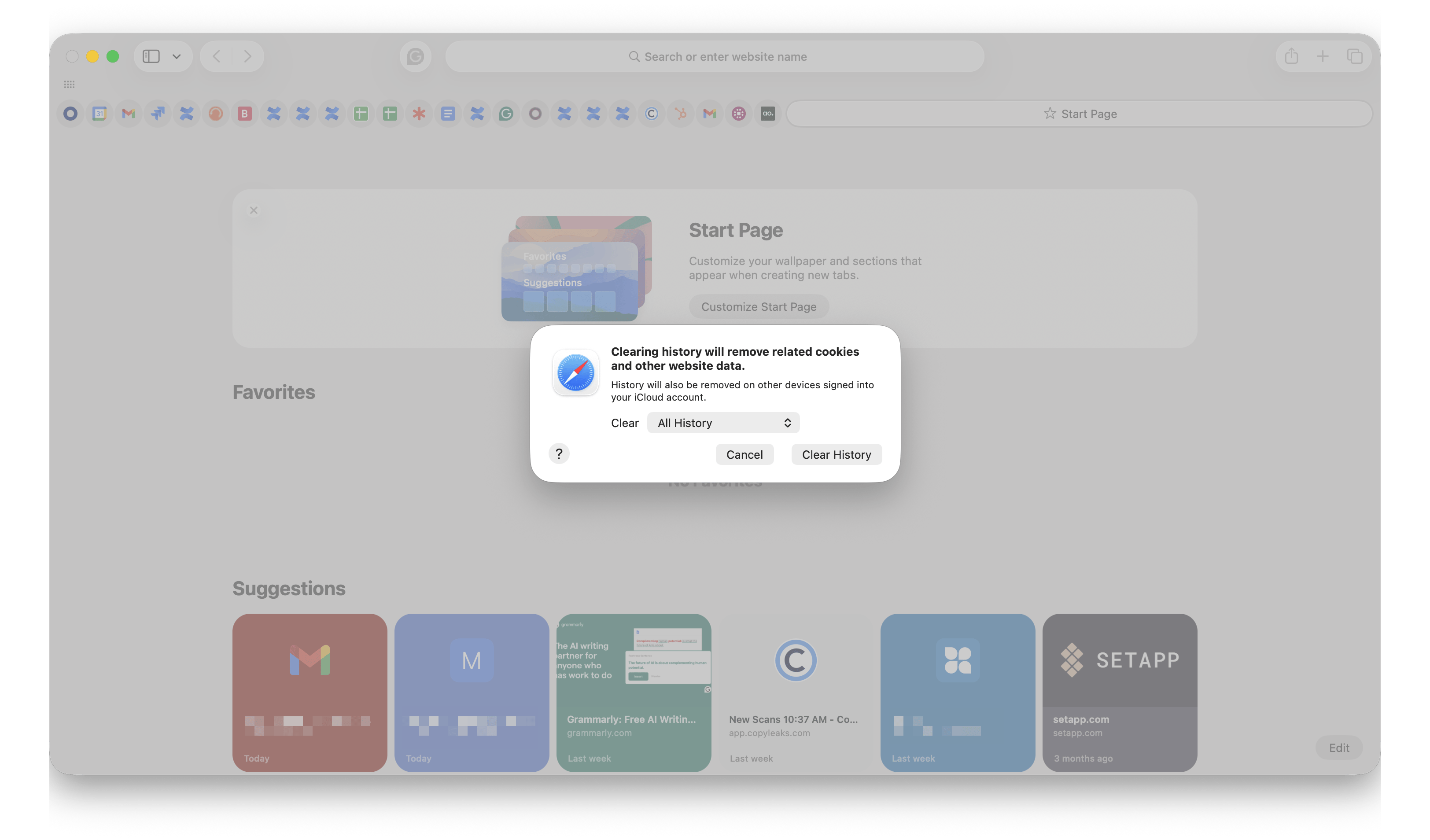
All the sites you’ve visited in the period specified by the option you’ve chosen will disappear from the History menu. That won’t remove all of the traces, however.
To get rid of data stored by the sites you’ve visited:
Click on the Safari menu > Settings.
Click the Privacy tab > Manage Website Data. You’ll see a window with a list of sites you’ve visited and notes on what data they store on your Mac.
If you want to remove all traces of every website you’ve been on, click Remove All. Otherwise, scroll through the list or search for a site whose data you want to delete, click on it, and Remove.
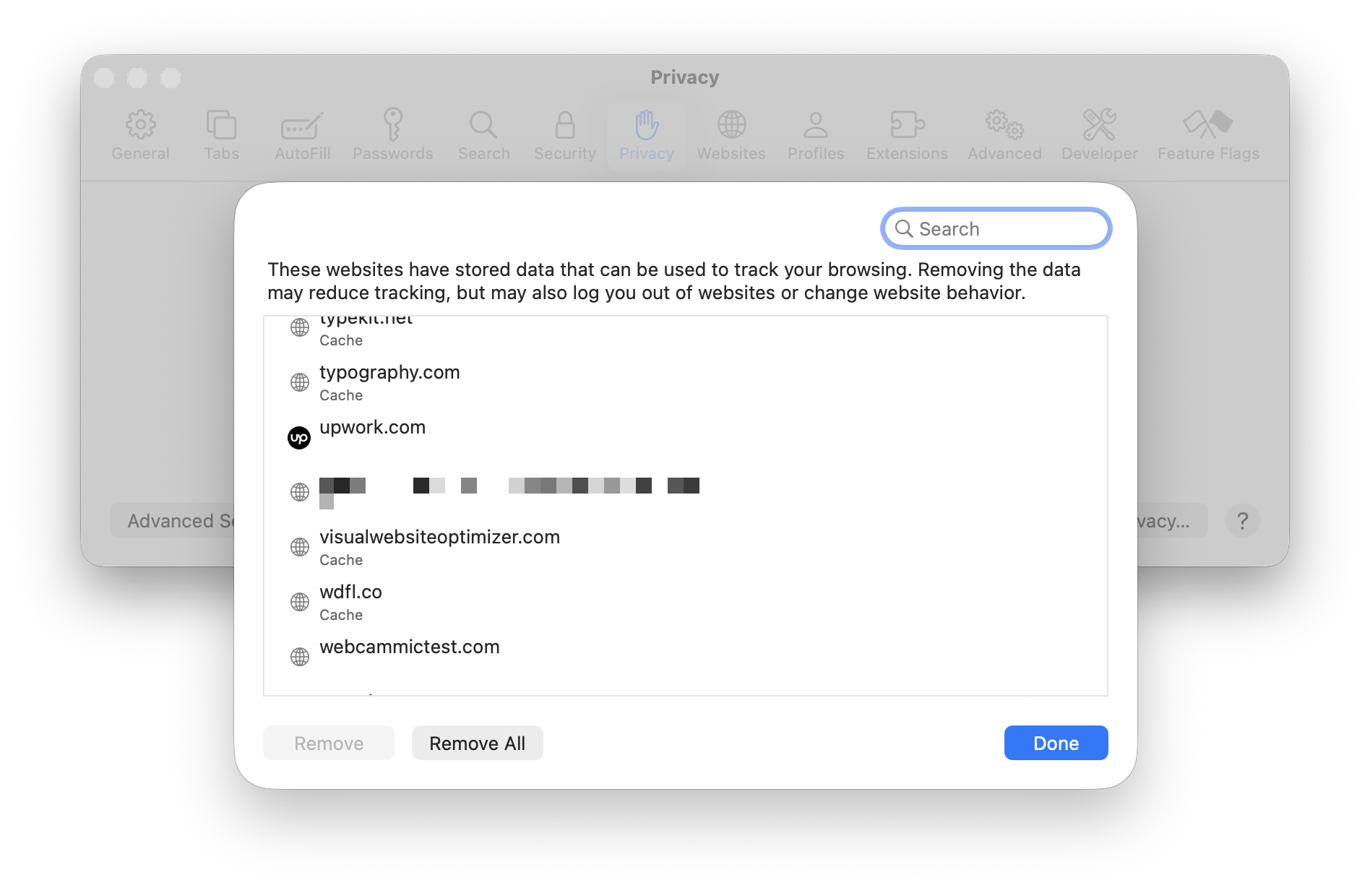
Tip: To remove specific sites from Safari history, go to History > Show All History (Command + Y), select the website(s), and Delete. Then, click Finder > Go > Go to Folder > Type ~/Library/Safari/Databases and also clear the Local Storage and Databases folders to fully remove stored website data.
Read also:
Clear search history in Chrome.
To clear Google Chrome browsing history:
Open Chrome, click History > Show Full History.
Delete browsing data in the left sidebar.
Choose a time period for which you want to clear data, and then select the boxes next to the data you want to delete.
Click Clear Data.
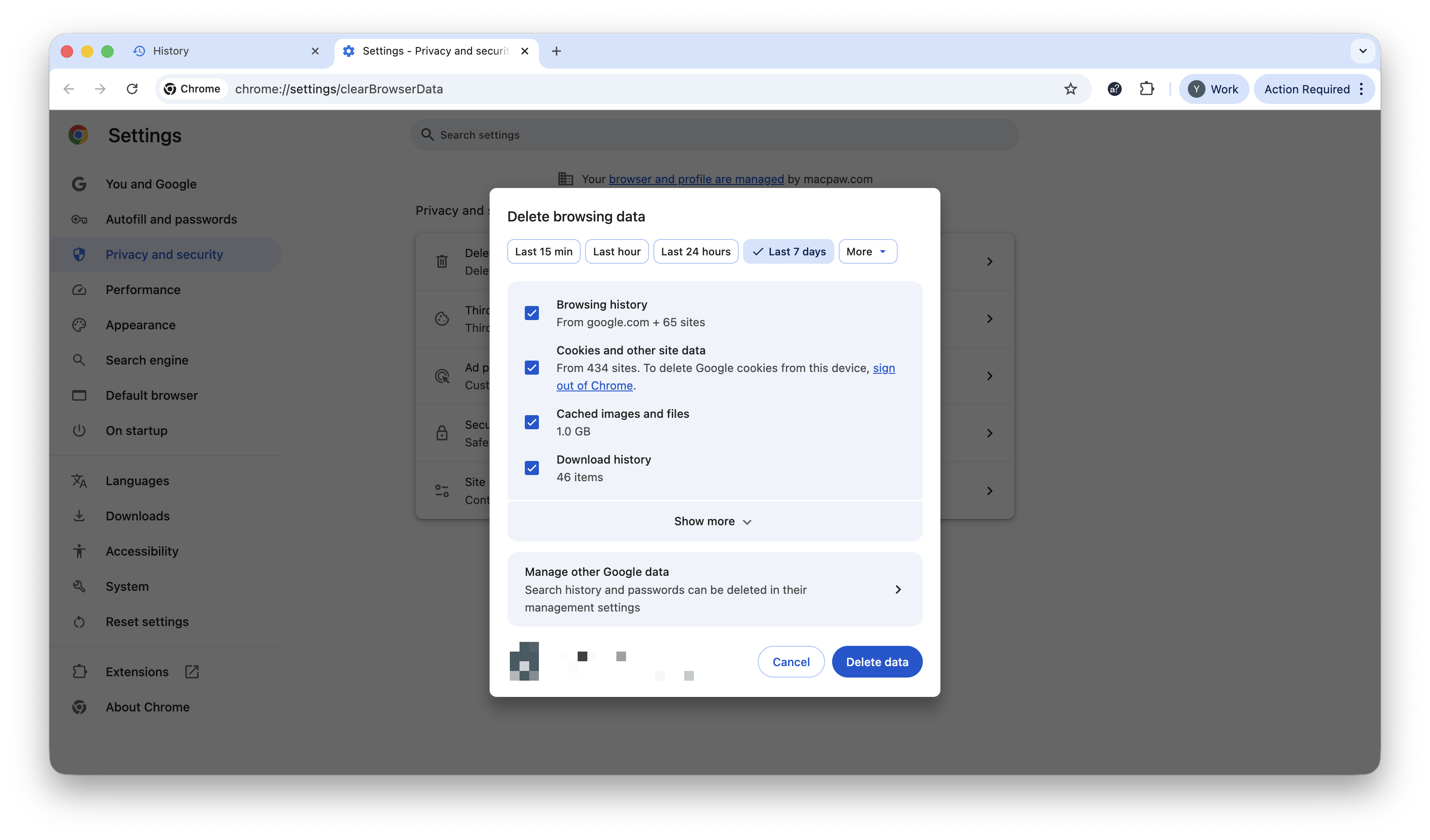
For complete privacy, you’ll also want to clear your Google account activity, which includes your YouTube and location history.
To delete multi-device searches and other activities of your Google account:
Go to myactivity.google.com.
Next to the Search My Activity bar, click the three dots
To delete all history, choose Delete activity by > All time > Delete.
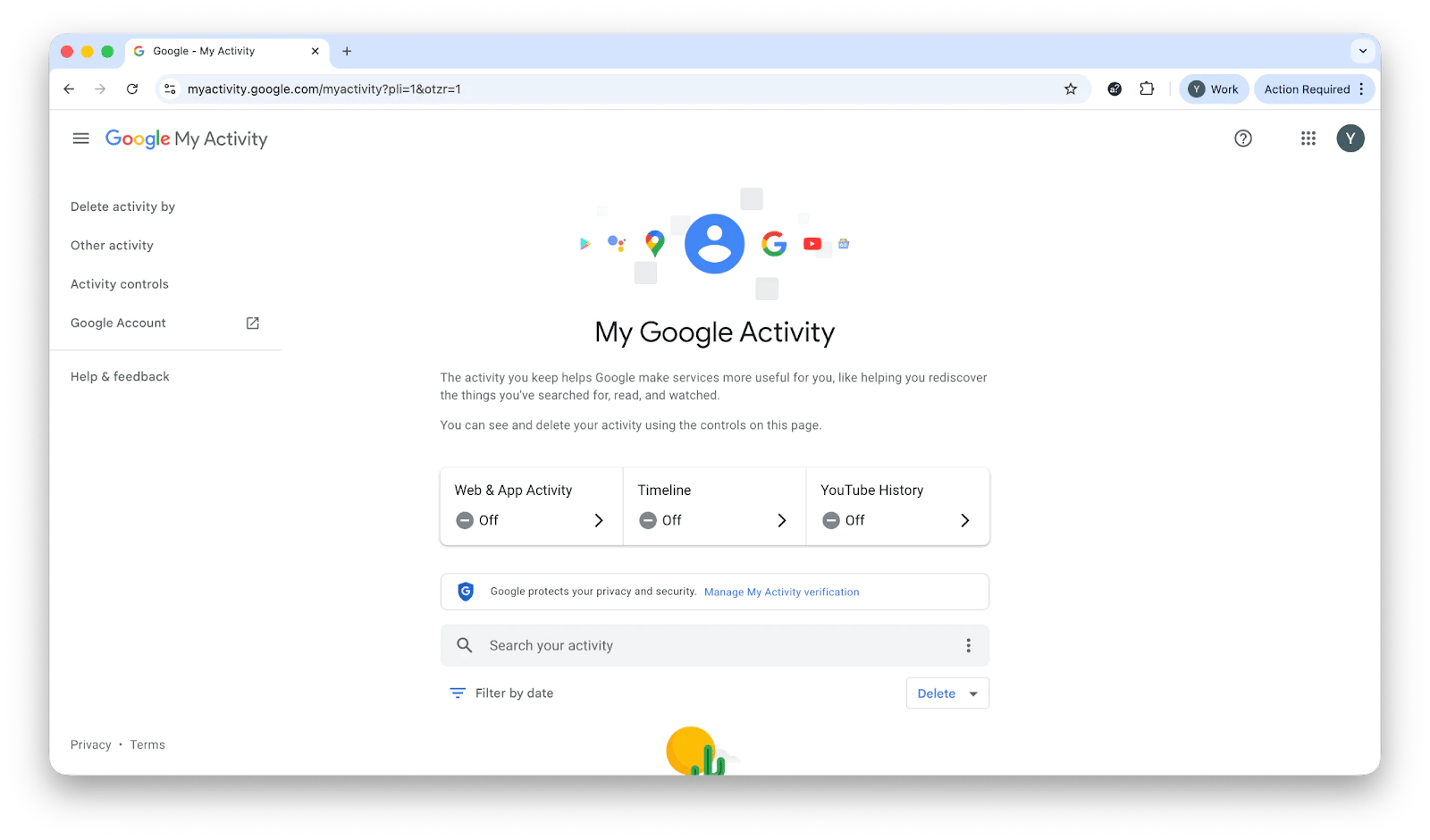
Learn more about how to manage saved passwords in Chrome.
Clear browsing history in Firefox
Firefox makes it straightforward to clear your browsing history with its built-in privacy tools:
Click on the History menu > Clear Recent History.
In a new window, choose all types of data you want to delete, and then select a time period for which you want to delete data.
Click OK.
To remove a specific item from your Firefox history:
Go to History > Show All History.
Find a URL you want to delete. You can filter by date or just start typing it.
Right-click and choose Forget About This Site.
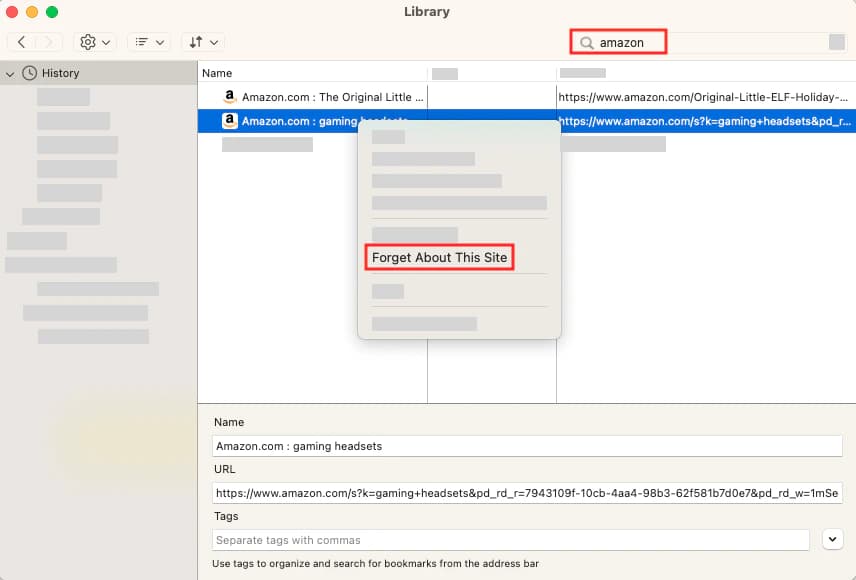
Source: support.mozilla.org
To prevent Firefox from ever storing history data, click on the Firefox menu and then Preferences (Command + ,). Under the History heading, choose "Firefox will" and then "Never Remember History."
Clear browsing history in Opera
If you use the Opera browser, you can delete certain pages from your browsing history or wipe your full history easily.
Here’s how to remove a page from your history:
Click History in Opera’s menu.
Choose Open full History view.
Locate the page you want to remove, then click the X next to it.
To clear the full history in Opera:
Click History in Opera’s menu.
Choose Show All History.
Choose Clear Browsing Data.
Set the time range to All time and check the box next to Browsing history.
Click Clear data.
Enable a VPN for secure browsing
To browse anonymously and access restricted content, use a VPN. It hides your IP, encrypts your traffic, and keeps your ISP from tracking you. But the VPN sees your activity, so choose a reputable provider with clear privacy policies and no hidden clauses.
ClearVPN is one of the most reliable — and prettiest — VPN apps for Mac and iPhone I know, which focuses on the tasks you want to solve. You don’t have to tinker with VPN settings; just choose what you need to do. For example, you can enable the Block ads & trackers feature that removes ad banners and trackers while browsing.
![]()
My takeaways on how to clear history on a Mac
In the end, you don’t have to be an FBI official to care about your browsing privacy. No matter where you go online, it’s pretty easy to make your personal data vulnerable. And sometimes you just don't want anyone to know how many YouTube videos you watch at work.
So make it a habit to regularly clear your search history with CleanMyMac to remove all the traces in one go, use a VPN like ClearVPN, and block ads and trackers with AdLock. All these apps and 250+ more are available on Setapp with a 7-day free trial.
FAQ
How do I clear my browsing history on my Mac?
To clear browsing history on Mac:
- Safari: Safari > Clear History > select time range > Clear History. For full removal, go to Safari > Settings > Privacy > Manage Website Data > Remove All.
- Chrome: Chrome > History > Show Full History > Clear Browsing Data > select time range and data > Clear Data.
- Firefox: History > Clear Recent History > select time range and data > OK. To remove specific sites, History > Show All History > Forget About This Site.
- Opera: History > Open Full History View > Clear Browsing Data > select time range and data > Clear Data.
- Automated: Use CleanMyMac (Protection > Scan > Manage Privacy Items) to remove history from all browsers at once.
What is the shortcut for clearing history on a Mac?
In Safari, press Command + Y to open all history, then select and delete items. Other browsers have similar shortcuts in their History menus.
How do you clear your search history on Safari?
Go to Safari > Clear History, choose a time range, and click Clear History. For complete removal, also clear Manage Website Data in Safari settings and delete the contents of ~/Library/Safari/Databases (Finder > Go > Go to Folder).
How do I clear recent activity on Mac?
Recent activity includes browser history, recently accessed servers, and files. Use CleanMyMac > Privacy > Recent Items List to remove recent activity and all traces quickly.
Why can't I clear browser history on Safari?
You can’t clear browser history on Safari because Content & Privacy Restrictions are enabled in Screen Time. Disable these restrictions: System Settings > Screen Time > Content & Privacy > Turn off.
Who can see my search history?
Your ISP, anyone with access to your Mac, or websites that track users can see browsing activity. Using a VPN like ClearVPN hides your IP and encrypts traffic for better privacy.
How do I erase my browsing history on my Apple iPhone?
To erase browsing history on iPhone, open Settings > Apps > Safari. Tap Clear History and Website Data. For Chrome, go to Chrome > History > Clear Browsing Data.
How can I recover deleted browsing history?
Deleted history may be recoverable with backups. Use Time Machine or Get Backup Pro if the history was saved before deletion.







